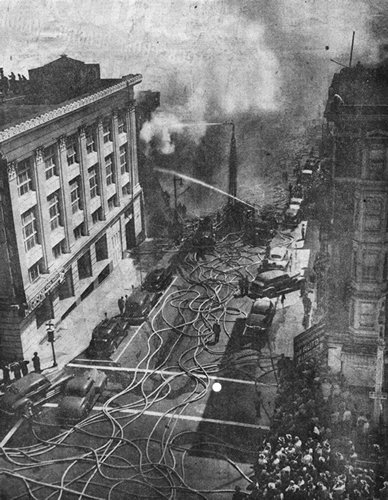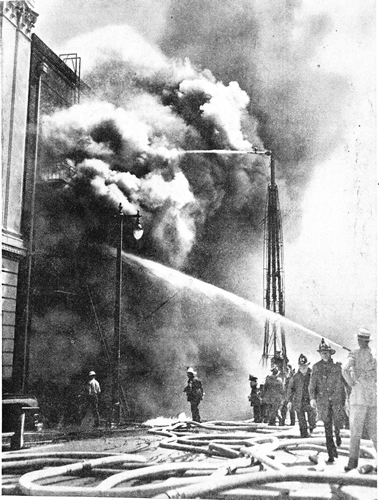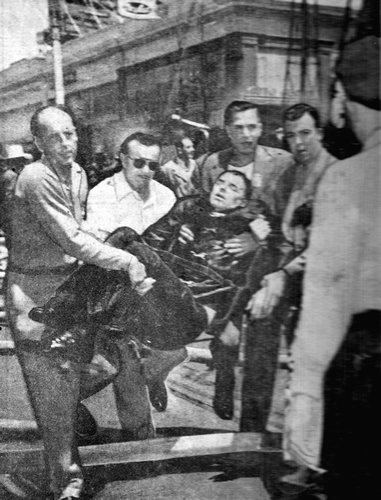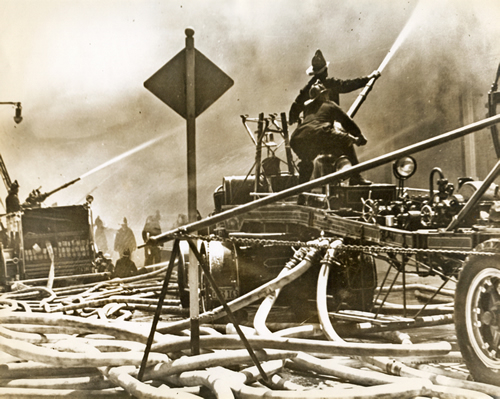|
FOURTH ALARM
Click here to view the video.
 |
 |
|
|
|
One fireman died and at least 30 others were injured today battling a fierce four alarm fire that raged out of control at Van Ness avenue and Bush street for more than two and one-half hours and threatened for a while to break out again with renewed fury. Estimates of damage ranged from $500,000 to $750,000.
The dead fireman, Battalion Chief Joseph Kane of District 1, was apparently stricken with a heart attack while fighting the flames at close quarters on the second floor of the burning building.
Forced time and time again to flee sudden flareups, other firemen escaped death by inches by sliding down high pressure water hoses to the street below.
But, as man after man was overcome by smoke inhalation, they showed a stubborn heroism that forced Dr. J. C. Geiger to issue a grim warning to the men battling the blaze.
"The worst thing' he said, "is that men injured no sooner get treated than they rush back to the fire again. Fatigue will get them sooner or later.”
So many fire fighters were treated at the scene for inhalation that portable oxygen supplies ran out and emergency reserves of the life giving gas were summoned from Central Emergency Hospital.

Capt. Gregg Truck Co. 1
TREATED 2D TIME
At least one man injured early in the blaze, John Slattery, was treated again this afternoon after he had returned to his post of duty, police reported.
Although he had earlier declared the blaze under control, Fire Chief Edward Walsh ordered all men out of the burning building again at 1 p. m.
"Men can't work in there because of the smoke,” one battalion chief explained.
Five minutes after the evacuation order was given, firemen began chopping a hole in the sidewalk on the Van Ness avenue side of the building to get at the basement where highly combustible paints and acids are stored.
A sudden explosion in the underground room sent a ball of flame mushrooming 15 feet into the air above the sidewalk,
"Good thing nobody was in there,' a fireman remarked.
Stubbornly, the blaze would retreat from the Van Ness side of the building as tons of water were poured into it—then it would roar anew on the Bush street side. And as the attack was renewed on Bush street, the flames gained strength again on the opposite side.
As firemen gradually gained the upper hand, there were no further explosions.
The blaze centered in two spots, one in the basement on the Van Ness avenue side, where 30 drums of lacquer were stored, and the other on the second floor on the Bush street side, where the flames could not be reached by the streams of water.
Roaring through the two and three story structure fronting on both of the main traffic arteries, the blaze—officially described as "one of the most dangerous in recent years'—sent a huge, ball-shaped pillar of smoke soaring-above Auto Row.
The entire Polk street business district was blanketed by the smoke which reached as far as the Nob Hill section, seven blocks away, where the sun was all but obscured.
Street traffic around the en¬tire area was diverted as more than 45 pieces of fire fighting apparatus and some 300 firemen and policemen were mobilized to fight the raging conflagration.
The building in which the fire started was an L-shapped structure occupied by the United Automotive Service, 1414 Van Ness avenue, and the Reid and Seilbell Beauty Shop Supply Company, 1412 Van Ness avenue.
Surrounded on two sides by the "L" were the Hughson Ford Agency showrooms, at the corner of Van Ness and Bush, where thousands of dollars worth of new automobiles were endangered.
The blaze started at about 10 a. m. and was brought under control at 12:24 p. m. but continued dangerous far into the afternoon:;
TRAFFIC DIVERTED
The minimum damage estimate of $500,000 was made by Fire Chief Walsh, who said $250,000 was represented in stock and $250,000 by value of the building.
Walsh said at 1:30 p. m. that he "thought" the fire was definitely under control again. That was an hour after it had first, been curbed after its initial out-burst of two and one-half hours.
More than a half-dozen times gas-masked firemen fought their way into the inferno, only to be forced back by the furnace-like heat.
Fire Chief Walsh called the conflagration "one of the most dangerous fires in recent years"; because of the paints and acids stored within the burning walls.
A total of 225 firemen, including 50 called back from off-duty hours, was mobilized around the scene.
Firemen battled against the flames from three sides—Van Ness, Bush and Austin street, an adjoining alley way—with virtually all the special equipment available in the city. Small and large water towers were called into play.
Starting suddenly on the Van Ness avenue side of the structure, the blaze mushroomed quickly and within a matter of minutes had sent a huge ball-headed pillar of flame above the heart of the city.
INTERIOR GUTTED
It spread rapidly through the structure, gutting the interior as it went. Firemen managed to drive the flames backward from the Van Ness side, where the building is two stories tall, but they mounted more fiercely on Bush street the building is three stories high.
Firemen on the Bush street side expressed belief the blaze may have started on the first floor near a stairwell. They said they smelled burning varnish.
Shooting tongues of flame threatened adjacent buildings.
OTHER SITES PERILED
One was the Timken Tapered Roller Bearings store at 1452 Bush street, next to the burning building. The other was a Fuller Paint Company branch store on Austin street. Firemen mounted the roof of the latter to pour water into the inferno.
Fire Chief Walsh refused to let firemen probe too deeply inside the structure in any of the sorties from the Austin and Bush street sides. He feared the charred walls might collapse and trap them.
So far as could be determined, the only person in the building when the fire broke out was Nick Bozzo, 42, of 57 Blake street, a janitor who was cleaning up. The company was closed for the day.
Bozzo said he was on the mezzanine floor when he smelled, smoke.
"I ran downstairs to the basement and then I opened the door in the basement on the alley side, where the shipping department is." he related.
"As I opened it a lot of smoke came out and I saw some flames. I ran out and turned in the alarm."
PROBE FOR ORIGIN
Fire Marshal Frank P. Kelly, chief of the fire prevention bureau, launched an investigation: into causes of the blaze.
He made it clear there was no reason to suspect arson.
The fire, he said, apparently broke out in the battery charging room maintained in the basement by the auto supply company. That was where Bozzo first saw the flames.
A short circuit was suggested as a possible cause of the blaze.
BURGLAR ALARM IN SHAPE
Discounting the arson possibility, Kelly said a burglar alarm system was in operation.
The janitor said he did not see or hear any other persons on the premises.
Investigation of the ruins showed a big circular hole in the floor of the building on the Van Ness side where the fire originally mushroomed.

Extracted from original sources with grammar and spelling as published.
Back to the Top |






